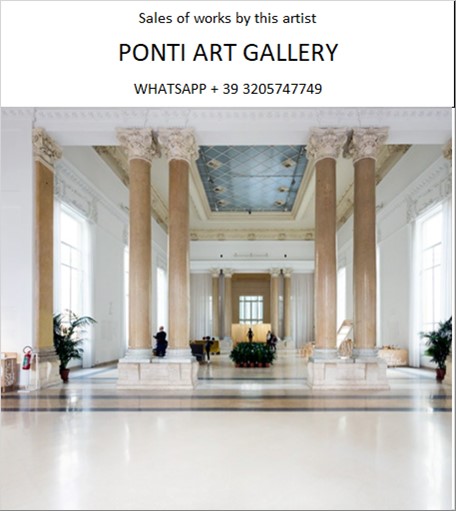Ponti Art Gallery is interested in buying and selling works
of art by this artist.

Richard Artschwager Biography
Richard Ernst Artschwager was an American painter, sculptor, and illustrator whose work defies easy categorization, straddling the lines between Pop Art, Conceptual Art, and Minimalism. Born on December 26, 1923, in Washington, D.C., to European immigrant parents, Artschwager's early life was marked by a blend of cultural and intellectual influences. His father, Ernst Artschwager, was a Protestant botanist from Prussia, and his mother, Eugenia (née Brodsky), was a Jewish Ukrainian amateur artist and designer who studied at the Corcoran School of Art. This diverse heritage provided Artschwager with a rich tapestry of cultural and artistic influences from a young age.
The family moved to Las Cruces, New Mexico, in 1935 due to his father's deteriorating health. It was here that Artschwager's talent for drawing began to emerge. Despite the early display of artistic talent, Artschwager initially pursued a scientific path, studying chemistry and mathematics at Cornell University after serving in the United States Army during World War II. His experiences during the war, including being wounded, would later influence his artistic work.
After completing his studies in 1948, Artschwager moved to New York City, where he was encouraged by his first wife, Elfriede Wejmelka, to study at the studio school established by Amédée Ozenfant, a French expatriate artist. This period marked a significant shift in Artschwager's career from science to art. However, before fully committing to his art, Artschwager engaged in various jobs, including furniture making, which would later have a profound impact on his artistic practice.
Artschwager's work in furniture design was both a livelihood and a form of artistic exploration. His furniture business thrived until a devastating fire in 1958 destroyed his studio and all its contents. This event, while tragic, prompted Artschwager to focus more intently on his art. He began experimenting with sculpture, using leftover industrial materials, and expanded into painting, drawing, site-specific installation, and photo-based work. His first exhibition took place at the Art Directions Gallery, New York, in 1959, followed by a significant solo exhibition with Leo Castelli in 1965.
Artschwager's work is characterized by its use of unconventional materials such as Formica and Celotex, a fire-retardant building material. These materials allowed him to explore the intersections between image and object, perception and reality. His sculptures often took the form of everyday objects, such as tables and chairs, rendered in "fake" materials, challenging viewers' expectations and perceptions. Similarly, his paintings on Celotex insulation boards mimicked the texture of newsprint, blurring the lines between high art and mass-produced imagery.
Throughout his career, Artschwager remained a protean figure, constantly defying easy classification. His work has been variously described as Pop Art, due to its derivation from utilitarian objects and incorporation of commercial materials; Minimal Art, because of its geometric forms and solid presence; and Conceptual Art, because of its cool and cerebral detachment. However, none of these labels fully encapsulate the breadth and depth of Artschwager's work, which sought to reveal the levels of deception involved in pictorial illusionism and to conflate the world of images with the world of objects.
Artschwager's influence extends beyond his own work, inspiring generations of artists who engage with the everyday and the mundane in innovative ways. His exhibitions have been held in prestigious institutions worldwide, including the Whitney Museum of American Art, the Museum of Contemporary Art, Los Angeles, and the Nouveau Musée National de Monaco, among others.
Richard Artschwager passed away on February 9, 2013, in Albany, New York, at the age of 89. His legacy continues to resonate within the art world, as his work challenges and expands our understanding of the relationship between art, objects, and perception.
Richard Artschwager Quotes and
Sales of Works
Ponti Art Gallery selects and deals with paintings by the
artist. Upon request, we provide free estimates and
evaluations, communicate prices, quotations, and current
market values.
If you are interested in BUYING or SELLING works by the
artist, contact us immediately.
If you wish to sell or receive an evaluation of the
works:
Send us a frontal photo of the painting, one of the back,
and one of the signature. Also, indicate the dimensions of
the work. Inform us about the purchase origin of the work
and any kind of available documentation (purchase
receipts, certificates of authenticity, publications). One
of our operators will respond to you on the same day. We
guarantee maximum confidentiality and extreme
professionalism.
If you wish to purchase works by the painter: Contact us
and let us know your request. We will inform you about the
available works. We also offer the possibility to
subscribe to our NEWSLETTER, through which you will be
informed at the beginning of each month about the latest
acquisitions of the art gallery.
You can send us pictures of the work:
